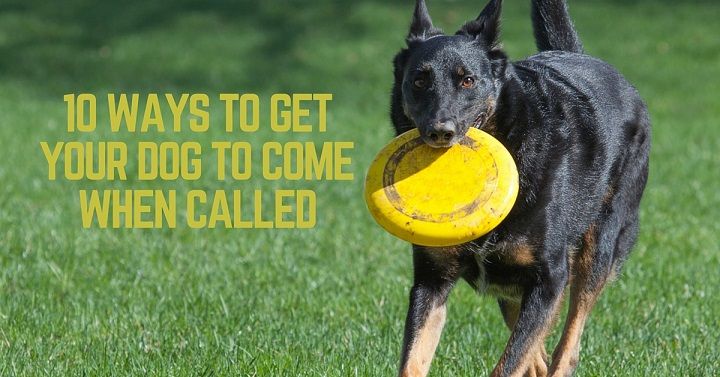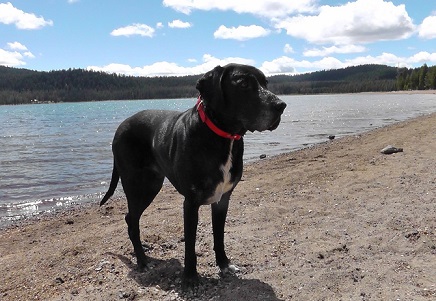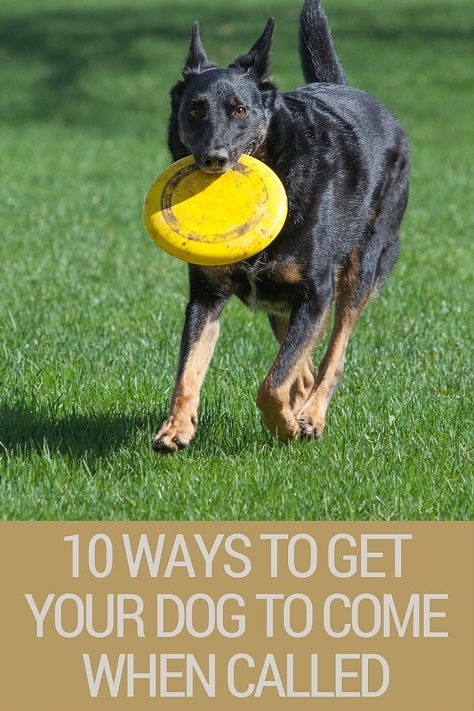Does your dog come when called, only to run right up to you and dart away again? Or does she come to you and run by you? Or maybe she just totally ignores you, or comes if she feels like it. Here are 10 things to consider while training your dog to come when called:
1. Teach your dog that come means “come and sit in front of me.”
It’s not good enough if Ace runs to me when I call him, and then immediately runs away again. In a controlled recall, the dog will come when called and then sit. It is simple to teach a dog to do this. When you call your dog, don’t praise her until she is sitting in front of you. (2019 update: Ace has passed away.)
2. Only call your dog when you are 90 percent sure she will come.

I don’t call Ace unless I know he will obey. If I let him get away with ignoring me, he will learn that listening to me is optional. Don’t give your dog this option. Only call her when you know she will respond, or if you can enforce it immediately. She might have to be on a leash or a long rope, or inside the house when you practice the recall, but that’s better than trying to teach a dog that already thinks she can do whatever she wants.
3. Only call your dog when she will get something positive.
Ace usually doesn’t like going in his kennel, so when it’s time for him to go in it, I don’t call him first. Don’t call your dog just because you want her to come to you. If she hates having her nails trimmed, don’t call her first. Just go and get her. Save practicing the recall for things your dog loves, like a walk, food, a car ride or your attention.
Also see my post: How to get your dog to come when called
4. Never call your dog and then punish her if she doesn’t come to you instantly.
I am guilty of scolding my dog when he finally ran to me after I’d called him five or six times. I was so angry at him for not coming fast enough. However, it was my own mistake in the first place for calling him at a time when I could not enforce the recall. It sounds obvious, but never show anger or frustration when a dog isn’t responding quick enough. Not doing anything at all is better than yelling at a dog.
5. Keep dog treats in your pockets at all times.
My mom almost always has dog treats in her pocket, and her springer comes when called 95 percent of the time or better. If you can give your dog a treat every time she comes, she will be more likely to always listen to you.

6. Find that one thing your dog loves and use that when you teach him to come when called.
If your dog is obsessed with a tennis ball like my mutt, then use that when you are practicing the recall. Use whatever it is that your dog will come for no matter what, whether it’s food, a toy, your attention, going for a walk or a car ride.
7. Never chase your dog after you call him.
No matter what, do not chase your dog, even when you aren’t practicing the recall. If you chase your dog, she will learn that running away is fun! If anything, run in the opposite direction and she will most likely end up chasing you. Until your dog will come reliably, just keep her on a long rope.
8. Make calling your dog a game.
If I call Ace and then run in the other direction screaming “Wooo hoooooo!!” he is guaranteed to come running after me, drool flying and tail wagging. It’s not that I have to do this every time, but playing this game now and then means Ace will associate the recall with fun and games.

Try something like this with your dog. Get her to chase you, or call her name and then hide in another room. Really make a big deal when she comes to you. My husband and I will play catch and call Ace back and forth between us. Try this with your dog, whether you use a ball or not. Call her back and forth between yourself and a family member or friend. She will love all the attention.
9. Think about your tone of voice when you call your dog.
With Ace, I have to either use a firm, serious voice or a really excited voice to get the best response for the recall. People often make the mistake of calling their dog too softly or with a high-pitched voice.
Does this sound familiar? “Come here baby! Come here! Come to Mommy!” Others sound too mean. Just be aware of your voice. Usually, a relaxed, serious voice is best, but every dog is different.
10. Don’t stop practicing the recall.
Even once your dog comes 95 percent of the time, keep practicing.
How do you practice teaching your dog to come when called?
Let us know in the comments!

Bonnie
Tuesday 1st of August 2017
Great ideas, I have a question. My Roxy is 2.5 . She loves everyone except puppies. She met my friend's puppy for the first time was growling and became possessive about toys. She snapped at the puppy. How do you correct this problem? Thanks
Keith Amdur
Sunday 8th of January 2017
Emma Lou (my Yellow Lab)comes when called 97% of the time which is pretty good.The main thing is to practice,practice and more practice.Out for a walk,in the house and around other dogs and people practice makes perfect or close to it.I walk dogs and I work on it with my walking pack too.They I look at it if one of my pack dogs gets loose from me for what ever reason I can get them back safely.
Jean Patterson
Wednesday 24th of August 2016
My 3 year old Rottweiler and I play hide and go seek in the FENCED in yard. I put him in a sit and stay, then go hide and call him. I have the treat ready for when he finds me. This is a game he and I both love. My favorite part is when he try's to sneak up and peek at where I am hiding... This helps tremendously with the recall...
Chuck Taylor
Tuesday 2nd of August 2016
The problem with keeping treats in your pocket, or trying to, is that my Dakotah smells them and knows that they are there and he constantly goes for that pocket. Even after they are all gone... the smell is still there and he tries for the 'ghost' treats. I have found that he really likes the cheese cubes that I bought. However, here in the Arizona heat, -and- my body heat, the cubes become one unless I carry them in a treat pouch, which I do on walks. However, I don't want to wear a treat pouch around the house all the time. But even IF I only have some Mini-Biskets he is more interested in them than what we are doing.
Daniel
Tuesday 26th of July 2016
Recalls have become our priority for the last 3 weeks. I've been training this everyday with a long line and using a good amount of treats that our dog is crazy about and only gets on recalls. He's been doing great so far. About the tone of your voice advice, I'd like to share: I've been using two cues, "aqui" (here in portuguese) for when he is closer and a loud whistle. I found that the loud whistle is really effective: It can be used from greater distances, it's unlikely to be poisoned by someone else (as it's unlikely that other people will use it and weaken the behaviour somehow) and I have the impression that its high pitch are able to get his atention better on distractions, don't know if that makes sense but yesterday I got to make Duque turn around when chasing a stray dog and come running at maximum speed, it was awesome and I could feel that all the training are paying off :)